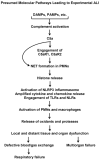Therapeutic targeting of acute lung injury and acute respiratory distress syndrome
- PMID: 26003524
- PMCID: PMC4635065
- DOI: 10.1016/j.trsl.2015.04.015
Therapeutic targeting of acute lung injury and acute respiratory distress syndrome
Abstract
There is no Food and Drug Administration-approved treatment for acute respiratory distress syndrome (ARDS), in spite of the relatively large number of patients with the diagnosis. In this report, we provide an overview of preclinical studies and a description of completed and future clinical trials in humans with ARDS. Preclinical studies dealing with acute lung injury have suggested roles for complement and complement receptors, as well as the evolving role of histones, but details of these pathways are inadequately understood. Anti-inflammatory interventions have not been convincingly effective. Various cell growth factors are being considered for clinical study. Interventions to block complement activation or its products are under consideration. Stem cell therapies have shown efficacy in preclinical studies, which have motivated phase I/II trials in humans with ARDS.
Copyright © 2016 Elsevier Inc. All rights reserved.
Figures


Similar articles
-
Recent progress and prospects for anti-cytokine therapy in preclinical and clinical acute lung injury.Cytokine Growth Factor Rev. 2023 Jun-Aug;71-72:13-25. doi: 10.1016/j.cytogfr.2023.07.002. Epub 2023 Jul 13. Cytokine Growth Factor Rev. 2023. PMID: 37481378 Review.
-
Delivery systems of therapeutic nucleic acids for the treatment of acute lung injury/acute respiratory distress syndrome.J Control Release. 2023 Aug;360:1-14. doi: 10.1016/j.jconrel.2023.06.018. Epub 2023 Jun 19. J Control Release. 2023. PMID: 37330013 Review.
-
The efficacy of mesenchymal stromal cell-derived therapies for acute respiratory distress syndrome-a meta-analysis of preclinical trials.Respir Res. 2020 Nov 20;21(1):307. doi: 10.1186/s12931-020-01574-y. Respir Res. 2020. PMID: 33218340 Free PMC article.
-
Therapeutic implications of mesenchymal stem cells in acute lung injury/acute respiratory distress syndrome.Stem Cell Res Ther. 2013 May 2;4(3):45. doi: 10.1186/scrt193. Stem Cell Res Ther. 2013. PMID: 23673003 Free PMC article. Review.
-
Advances of mesenchymal stem cells and their derived extracellular vesicles as a promising therapy for acute respiratory distress syndrome: from bench to clinic.Front Immunol. 2023 Aug 29;14:1244930. doi: 10.3389/fimmu.2023.1244930. eCollection 2023. Front Immunol. 2023. PMID: 37711624 Free PMC article. Review.
Cited by
-
Anti-inflammatory interventions-what has worked, not worked, and what may work in the future.Transl Res. 2016 Jan;167(1):1-6. doi: 10.1016/j.trsl.2015.08.003. Epub 2015 Aug 14. Transl Res. 2016. PMID: 26323016 Free PMC article.
-
LL-37 Attenuates Sepsis-Induced Lung Injury by Alleviating Inflammatory Response and Epithelial Cell Oxidative Injury via ZBP1-Mediated Autophagy.Toxins (Basel). 2025 Jun 17;17(6):306. doi: 10.3390/toxins17060306. Toxins (Basel). 2025. PMID: 40559884 Free PMC article.
-
Glucocorticoid therapy for acute respiratory distress syndrome: Current concepts.J Intensive Med. 2024 Apr 1;4(4):417-432. doi: 10.1016/j.jointm.2024.02.002. eCollection 2024 Oct. J Intensive Med. 2024. PMID: 39310055 Free PMC article. Review.
-
Soluble Epoxide Hydrolase Inhibitor Attenuates Lipopolysaccharide-Induced Acute Lung Injury and Improves Survival in Mice.Shock. 2017 May;47(5):638-645. doi: 10.1097/SHK.0000000000000767. Shock. 2017. PMID: 27753791 Free PMC article.
-
Corticosteroids in Acute Lung Injury: The Dilemma Continues.Int J Mol Sci. 2019 Sep 25;20(19):4765. doi: 10.3390/ijms20194765. Int J Mol Sci. 2019. PMID: 31557974 Free PMC article. Review.
References
-
- Ware LB, Matthay MA. The acute respiratory distress syndrome. The New England journal of medicine. 2000 May 4;342(18):1334–49. - PubMed
-
- Rubenfeld GD, Caldwell E, Peabody E, et al. Incidence and outcomes of acute lung injury. The New England journal of medicine. 2005 Oct 20;353(16):1685–93. - PubMed
-
- Hudson LD, Steinberg KP. Epidemiology of acute lung injury and ARDS. Chest. 1999 Jul;116(1 Suppl):74S–82S. - PubMed
-
- Dever LL, Johanson WG., Jr Pneumonia complicating adult respiratory distress syndrome. Clin Chest Med. 1995 Mar;16(1):147–53. - PubMed
-
- Marshall RP, Bellingan G, Webb S, et al. Fibroproliferation occurs early in the acute respiratory distress syndrome and impacts on outcome. Am J Respir Crit Care Med. 2000 Nov;162(5):1783–8. - PubMed
Publication types
MeSH terms
Substances
Grants and funding
LinkOut - more resources
Full Text Sources
Other Literature Sources

